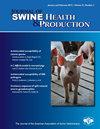补充材料:每天的用水模式:商业生产系统中不同批次生长猪的变化
IF 0.7
4区 农林科学
Q3 Agricultural and Biological Sciences
引用次数: 0
摘要
目的:测量、描述和比较农场建筑物中多组断奶猪、生长猪和育肥猪每天的用水模式。材料和方法:在5个猪舍中进行了每天用水模式的前瞻性观察队列研究,使用涡轮机或超声波水表连接在每个建筑物的主水管上。收集了多批次猪的用水数据(11个48天的第二断奶期和4个21-43天的生长育肥猪)。为了估计时间和猪体重对猪用水的交互影响,我们使用了时间和猪体重的张量积平滑来估计猪每天用水模式的半参数模型。结果:各组之间每天的用水模式不同,许多组的模式随着猪体重的增加而改变。一些模式为单峰模式,另一些模式为双峰模式,用水高峰出现在下午早些时候到下午晚些时候。含义:猪每天的用水模式在同一群之间和同一群之间是不同的。一个群体的用水模式不能可靠地用来预测其他群体的用水模式,即使他们是在同一栋楼里长大的。用水模式数据可能对优化水中抗菌素给药方案有价值。本文章由计算机程序翻译,如有差异,请以英文原文为准。
Supplementary Material: Water use patterns within each day: Variation between batches of growing pigs in commercial production systems
Objective: To measure, describe, and compare the water use patterns within each day for multiple cohorts of weaner, grower, and finisher pigs in farm buildings. Materials and methods: Prospective, observational cohort studies of the water use patterns within each day were conducted in 5 pig buildings using either a turbine or ultrasonic water flow meter attached to the main water pipe entering each building. Water use data were collected from multiple batches of pigs (second-stage weaners over eleven 48-day periods and grower-finishers over 4 periods of 21-43 days). Semi-parametric models of pig water use patterns within each day were estimated using the brms software package in R. To estimate the interacting effects of time and pig body weight on water use by pigs, we used tensor product smooths for time and pig body weight. Results: The water use pattern within each day varied between the cohorts, and the pattern of many cohorts changed as the pigs gained weight. Some patterns were unimodal and others were bimodal, with the main peak in water use occurring early afternoon to late afternoon. Implications: Water use patterns of pigs within each day varied between and within cohorts. The water use pattern of one cohort cannot be used reliably to predict that of other cohorts, even if they are reared in the same building. Water use pattern data may be valuable for optimizing in-water antimicrobial dosing regimens.
求助全文
通过发布文献求助,成功后即可免费获取论文全文。
去求助
来源期刊
CiteScore
1.80
自引率
0.00%
发文量
29
审稿时长
>36 weeks
期刊介绍:
The Journal of Swine Health & Production (JSHAP) is an open-access and peer-reviewed journal published by the American Association of Swine Veterinarians (AASV) since 1993. The aim of the journal is the timely publication of peer-reviewed papers with a scope that encompasses the many domains of applied swine health and production, including the diagnosis, treatment, management, prevention and eradication of swine diseases, welfare & behavior, nutrition, public health, epidemiology, food safety, biosecurity, pharmaceuticals, antimicrobial use and resistance, reproduction, growth, systems flow, economics, and facility design. The journal provides a platform for researchers, veterinary practitioners, academics, and students to share their work with an international audience. The journal publishes information that contains an applied and practical focus and presents scientific information that is accessible to the busy veterinary practitioner as well as to the research and academic community. Hence, manuscripts with an applied focus are considered for publication, and the journal publishes original research, brief communications, case reports/series, literature reviews, commentaries, diagnostic notes, production tools, and practice tips. All manuscripts submitted to the Journal of Swine Health & Production are peer-reviewed.

 求助内容:
求助内容: 应助结果提醒方式:
应助结果提醒方式:


